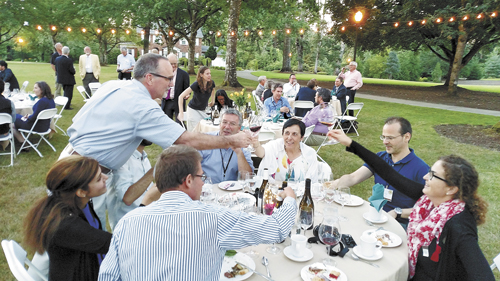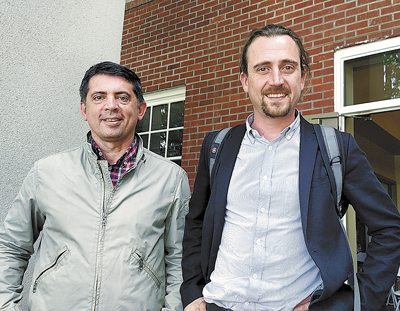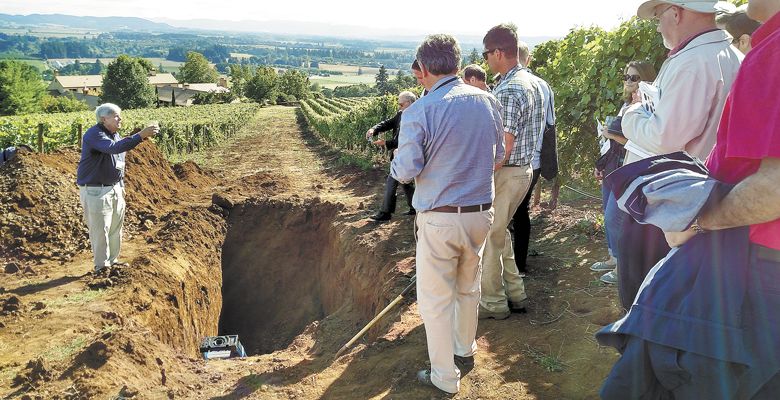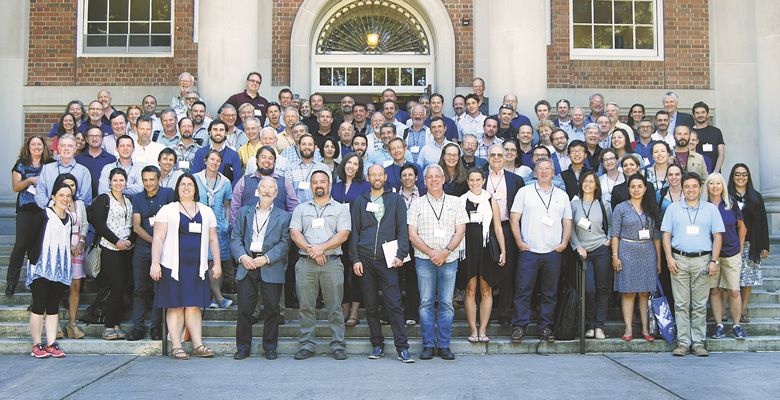Talking Terroir
Eleventh International Terroir Congress convenes in Oregon
Eric Asimov once wrote, “If you want to start an argument in the wine world — and believe me, it’s not hard to do — all you have to do is mention the word ‘terroir.’”

For those attending the 11th annual International Terroir Congress at Linfield College in McMinnville, the discussions about the subject were educational, not so confrontational, as brilliant minds from the world wine community — Argentina, Australia, Austria, Brazil, Canada, Chile, Finland, France, Greece, Germany, Hungary, New Zealand, Italy, Portugal, Serbia, Slovenia, Switzerland and the U.S. — covered topics as varied as their accents.
During the five-day conference, intricate composites of data filled the room via screens and presenters, both new to the field and veterans, alike. From the levels of potassium in alternating soil types of Virginia, to the ongoing studies on how drainage affects roots in Portugal, papers revealed fine detail.
What is terroir? A simplified definition: the complete natural environment in which a particular wine is produced, including factors such as soil, topography and climate, and the resulting characteristic taste and flavor imparted to a wine from the environment in which it is produced.

Terroir is complicated, to say the least. There are countless soil types, climates, microclimates, trends, beliefs and environmental effects, and nearly as many ideas on how to define the all-encompassing word. Each year, the congress sets out to explore terroir from a scientific point of view; each year the nuances revealed are as layered as the most complex of wines.
One of the most compelling presentations was delivered by Portland State’s Dr. Scott Burns. “The Importance of Soil and Geology in Tasting Terroir: A Case History from the Willamette Valley, Oregon.” Although his expertise is geology and soil, Burns’ grasp of terroir’s many components was evident.
“Seven main factors affect the taste of a wine,” Burns explained. “They are the different types of grapes, the geology and resulting soils, the climate, the soil hydrology, the physiography of the site, the winemaker and the vineyard management techniques. The first five of these factors comprise what the French call terroir, ‘the taste of the place.’ Terroir differs from wine region to wine region around the world.”
Following in his footsteps, Burns’ PhD student, Kathryn Nora Barnard, focused on Oregon’s most celebrated varietal in her research, “The Terroir of Pinot Noir Wine in the Willamette Valley, Oregon: A Broad Analysis of Vineyard Soil, Grape Juice and Wine Chemistry.”
From her presentation: “The hypothesis is that the physical and chemical differences in the soil can be compared to the grape juice and wine chemistry to determine the contribution of soil to the terroir of this region. Using Pinot Noir, a natural laboratory exists in the Willamette Valley, one where if winemaking techniques are kept constant when comparing soil, grape juice and wine from each winery, then the main variation between the wines is the soil type on which the grapes are grown (Burns 2012). In general, winemakers determined that the tannin, fruit flavors and mouthfeel were so different between soil types that a cause for these differences was desired...”
Burns reinforced soil’s grand effect on Oregon wine with a quote from winemaker Ken Wright: “To understand Oregon is to understand geology.”
In addition to soil and geology, presentations included: climates of wine regions worldwide; plant management across different terroirs; terroir zoning techniques; landscape/environmental sustainability and biodiversity; understanding and managing wine production from different terroirs; and the social constructs of terroir: tourism, economics and cultural ideals.
Thanks to the determination of climatologist Greg Jones of Southern Oregon University, the event was hosted in Oregon. His diligence led to a successful congress welcoming the world’s wine elite in our own backyard. The camaraderie witnessed among the attendees and the exposure of Oregon wine was a bonus for local organizers, including Jones, who continues to show great dedication to his own research and the advancement in winegrowing.
“If part of the result of my work is that the region grows, gains recognition as a fine wine-producing region and people are successful, then I have succeeded in being a scientist,” he said.
In addition to the presentation of papers, participants experienced some of Oregon’s own terroir at site visits and dinners hosted by the Dundee Hills, McMinnville and Chehalem Mountains AVAs. A gala dinner in Linfield’s Oak Grove concluded the congress until next year.
Burgundian winegrower Jean-Yves Bizot of Vosne-Romanée once wrote, “At last, and maybe above all, terroir is a state of mind, a humbler attitude in front of nature.”
For this writer, having witnessed this once-in-a-lifetime event, I have a much greater respect for terroir and its many, many implications.
Conclusion? Wine is definitely made in the vineyard.
From his first sip of wine to the last Scotch tasting, Ryan Stevens has loved the craft and the journey behind the bottle. As a contributor for Busted Wallet and Ask Men, he has found his niche showcasing the nuances behind the vices that make life a celebration.












